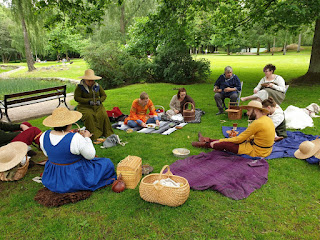So, the plan is to make 14th-16th century style hanboks for both Valeria and Maja. I started yesterday, at Gotvik's sewing meeting, by making a chima (wrap skirt) for Maja from a linen/cotton blend. Ideally it should be hemp or cotton for lower class garb, and ramie or silk for higher class, but this is such a lovely fabric. And it has stripes, which was popular for unmarried girls and women.
The chima was pretty easy to research, there are several preserved ones from this period, such as these:
A chima made for Jung, On (1481~1538), a 5th class officer in the reign of King Joongjong. It is made of fine tabby silk and has various Buddhist scriptures around the knee portion. This suggests that this Chima was specially made for a placement in coffin as an element of the burial, and also as an offering for the late husband’s soul to rest in peac
From Google Arts&Culture
This unlined ceremonial Chima was worn by Lady Han of Cheongju (region), a great-grand child of King Joongjong. It is made of satin damask with a lotus and seven treasures pattern and is decorated with two lines of satin tapes made with supplementary golden wefts to create a lotus and child pattern.
From Google Arts&Culture
But I need more info for the rest of the outfit. I have ordered Traditional Korean Costume on ILL, and I have found two blogs with historical info, as well as a wonderful artist on DeviantArt who draws historical Korean outfits.
A hanbok fit for a 16th century Gisaeng.
So steady as she sews
Glimja at DeviantArt
And I am ever so grateful for the Metropolitan Museum of Art for making so many of their publications free to download. Like this: Art of the Korean Renaissance.
My Pinterest page on Korean dress, which includes later periods




































